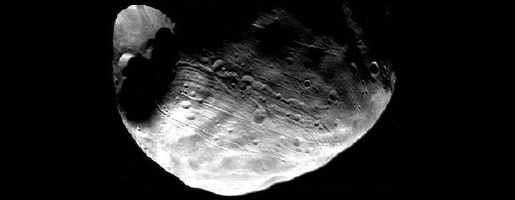 |
|||
|
Viking
Orbiter 1 view of Phobos and Stickney crater from 1600 kilometres.
|
|||
| PHOBOS - MOON OF MARS | |||
| Phobos is the innermost moon of Mars and the largest - the other moon is Deimos. In common with many of the small bodies of the Solar System, very little is known about Phobos. The word Phobos derives from the Greek word for fear, an appropriate name as Phobos accompanies Mars, the god of war. In Greek mythology Phobos was the son of Ares (Mars) and Aphrodite (Venus). | |||
| A Unique Orbit | |||
| The orbit of Phobos is unique - of all the moons in the Solar System, Phobos is the one that travels nearest to its parent planet. If you stand on the Martian surface, you will see Phobos rise in the west and set in the east. As Phobos orbits Mars once every 7 hours and 39 minutes (faster than the rotation of Mars), you will see Phobos rise and set twice a day. However, Phobos travels so close to Mars it cannot be seen at all from some places as the horizon gets in the way. Phobos can come as close as under 6000 kilometres to the surface of Mars - compare this to our own Moon, which orbits Earth at 384,000 kilometres. | |||
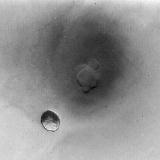 Viking Orbiter 2 looked down to see Phobos travelling over the Martian shield volcano Ascraeus Mons. |
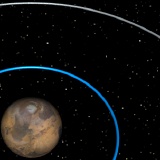 The orbit of Phobos. |
||
| Phobos is doomed, as tidal forces are slowly lowering the orbit and dragging the moon towards a collision with Mars. Either there will be an impact in some 30 million years time, or Phobos could be broken up to form a ring system. Mars could be reduced to having only one moon like Earth, or could join the gas giants with its own rings. The unstable orbit of Phobos is a clue to the origin of Phobos. | |||
| Like many other moons, Phobos has a synchronous rotation. This means that Phobos rotates on its own axis in the same time that it takes to complete one orbit of Mars. The result is that the same part of Phobos is always pointed towards Mars. | |||
| Physical properties | |||
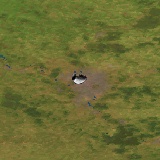 Comparison between Phobos and Earth. |
|||
| Phobos is one of the smaller moons of the Solar System, with a diameter of only 27 kilometres. Measurements made by the Soviet spacecraft in 1989 show that the density of Phobos is low (2000 kg m-3), in fact lower than that of meteorites. | |||
| Interior | |||
| The low density of Phobos suggests that it is made up of material rich in light elements. The deep interior may consist of water ice. | |||
| Magnetic field | |||
| No magnetic field has been detected. | |||
| Atmosphere | |||
| Phobos 2, a Soviet spacecraft that made a flyby of Phobos, possibly detected some outgassing from the moon. However, the spacecraft died before identifying the gas, which was most probably water. There has been no other detection of an atmosphere. | |||
| Surface | |||
| Phobos has a very dark, grey-black cratered surface, with only 6% of the sunlight being reflected back into space, making it darker than the maria of Earth's moon. This low reflectivity is similar to the asteroids, and gives another clue to the origin of Phobos. | |||
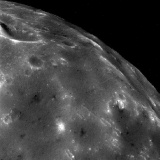 Viking Orbiter 1 view of the dark surface of Phobos from a distance of 350 kilometres |
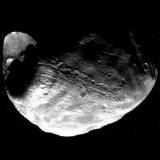 Viking Orbiter 1 view of Phobos and Stickney crater from 1600 kilometres. |
||
| Phobos appears to have a surface untouched by any activity apart from cratering, and the surface's age is estimated to be about three thousand million years. | |||
| Craters | |||
| Phobos has three large craters, Stickney, Hall, and Roche, and numerous smaller ones. Stickney is very large (10 kilometres) compared to the overall size of Phobos, and the impact that caused it came close to destroying the moon. A similar situation occurred at Saturn's moon Mimas. | |||
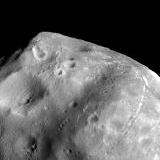 Viking 1 Orbiter image of Hall crater and Phobos' south pole. |
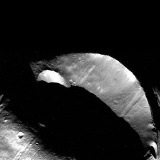 Viking 1 Orbiter image of Stickney crater, the largest crater on Phobos. |
||
| Grooves | |||
| Unusually, Phobos also has long grooves, up to 20 kilometres long, and travelling all the way around the moon. The grooves are about 200 metres wide, and between 5 and 30 metres deep. Due to the low surface gravity of Phobos, it would be easy to jump those 30 metres from the bottom of a groove to the top. | |||
| The grooves appear to be connected to Stickney crater, and may have formed when Stickney was created. One theory is that the heat generated during the impact that formed Stickney caused high speed gases to flow across Phobos, cutting a series of grooves into the surface. | |||
 Linear features and crater chains cross the surface of Phobos. |
 Viking 1 Orbiter view of linear features on Phobos. |
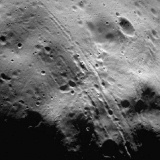 Viking 1 Orbiter image showing some of the linear features that radiate from Stickney crater. |
|
| Powder | |||
| Phobos appears to be covered with a layer of powder, created over millions of years by the bombardment of small meteoroids. The most recent images of Phobos, obtained by the Mars Global Surveyor (MGS) spacecraft, show small boulders partly buried in powder, and light and dark streaks inside the bowl of Stickney crater, evidence of material slowly rolling downhill. | |||
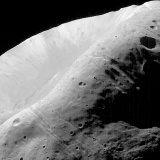 Mars Global Surveyor view of Stickney crater and boulders buried in powder. |
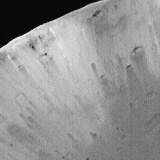 Close-up view of the inside of Stickney crater. |
||
| A covering of powder also explains the temperature measurements made by MGS. The daytime Phobos temperature is -4 oC, like a cold winter's day, while the nighttime temperature drops to -112 oC, colder than nighttime Antarctica. Such a large temperature drop over a short period of time (the moon rotates in under 8 hours) is explained by a layer of powder that is incapable of retaining heat and allows the surface to radiate heat rapidly into space. The powder of Phobos is not unique - layers of dust can be found elsewhere in the Solar System, for example Callisto's surface. | |||
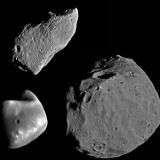 Comparison of Phobos (right), Deimos (left), and Gaspra (top). |
|||
| Origin of Phobos | |||
| The material that makes up Phobos is different from that which makes up Mars, indicating that Phobos and Mars did not form at the same place in the Solar System. One possibility is that Phobos comes from the asteroid belt, and the gravitational effects of the planets then pushed Phobos into a Mars orbit. It is known that some asteroids do cross the orbits of Mars and Earth, having been responsible in the past for impact craters on the inner planets. | |||
| A comparison of Phobos with other small moons, like Deimos, and asteroids, like Gaspra , show the similarities that point to a common origin. The unstable orbit of Phobos is unsurprising if Phobos is indeed a captured asteroid. Had Phobos been formed with Mars thousands of millions of years ago, then the fact that Phobos exists today indicates a long-term stable orbit. If Phobos is a captured asteroid, there is no reason why the capture should have resulted in a stable orbit. | |||
| Exploration of Phobos | |||
| Aseph Hall discovered Phobos in 1877 when using the 26 inch refractor telescope at the Washington US Naval Observatory. Hence one of the craters on Phobos is called Hall. | |||
| After the initial discovery, very little was known about Phobos until recent years - Phobos has now been imaged by no less than eight spacecraft. | |||
|
|
|||